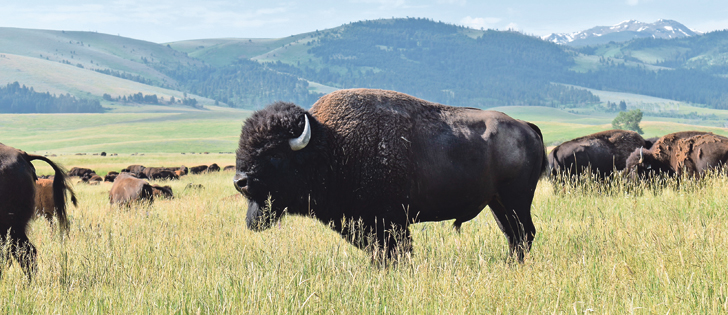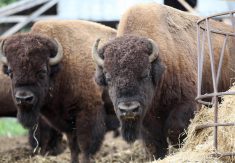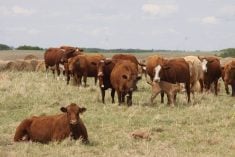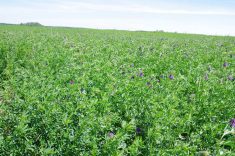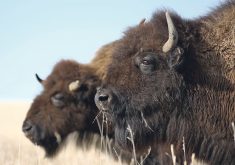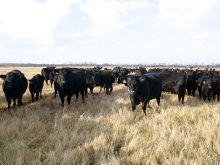BIG SKY, Mont. — Climate change could lead to diminishing protein in feed for livestock, says an American ecologist who studies animal diets and grasslands.
In fact, he said the protein content in grass and forage has already dropped and the slow decline has escaped major attention.
Joseph Craine, co-founder of Jonah Ventures and former researcher at Kansas State University, told those at the International Bison Congress July 5 that data shows protein concentrations on grazing lands are declining throughout North America and dropped by about 10 percent between 1995 and 2015.
Read Also

Farming Smarter receives financial boost from Alberta government for potato research
Farming Smarter near Lethbridge got a boost to its research equipment, thanks to the Alberta government’s increase in funding for research associations.
“It’s been something that’s been gradual. It’s been chronic and it hasn’t really been noticed because we haven’t been measuring it and looking at it,” said Craine.
He used data from 36,000 cattle manure samples collected by Texas A & M University over a 22-year period and screened out those from cattle given supplemental feed so he could focus on grazing. He published a scientific paper on his findings in March.
“Protein is the main driver of weight gain for these animals out in the field. It’s the main limiting factor for how much weight these animals put on in a year. It’s cattle, it’s bison,” he said.
Crude protein content in feed has declined to 9.5 percent from 10.5 percent in a 10-year period ending in 2015, according to the data.
Given that there are about 80 million cattle in the United States and that protein is vital to productivity, Craine estimated the cost of loss of crude protein at $2 billion.
Surya Acharya, a research scientist and forage breeder with Agriculture Canada, said there are many variables affecting protein content in grass and forages and he would need to see replicated studies before accepting Craine’s position.
“I think it is possible that if he happens to collect material or manure from an old stand … and over the years the stand is not being fertilized, the protein content may go down, but I don’t think it would be a general thing everywhere,” said Acharya.
“I don’t think you can attribute that directly to climate change.”
Craine said more carbon dioxide in the atmosphere reduces plant protein for a variety of reasons, so his best guess is that global warming will reduce plant protein concentrations all over the world.
In an interview, Craine said he doesn’t think the cattle industry is aware of the slow decline in crude plant protein. The manure samples in Texas were primarily collected for short-term management purposes rather than longer-term protein analysis that shows the reduction.
“It’s probably going to get worse,” he said.
“The scary part about it is that more than likely all of that has happened and we haven’t noticed. We understand that cattle weights have been increasing over time, but that’s probably in large part due to genetics overriding these other signals that we have.
“But when you think about it, if we had one percent higher crude protein throughout the entire U.S., the amount of secondary feeding we would have to do would be a lot less.”
Acharya said improved cattle genetics could have affected Craine’s research in a different way.
“If the samples were collected mostly on grasses, one variable thing I would say would be the cattle over the years, probably they’re becoming more and more efficient to utilize the nutrient in the feed,” he said.
That would mean less crude protein expelled in the manure.
“Second would be that the grass itself, if they are not fertilized on a regular basis, the older stands would have less nitrogen to actually take up so the nutrient value of old stands would be slightly lower.”
Craine’s speech to producers focused on the climate forecast for bison specifically, although protein content has implications for all livestock. He used cattle manure samples as a proxy for bison because data for the latter animals is not available.
“If we want to have bison that graze on grasslands that were similar to what we had a couple decades ago, no less what we had in 1900, that’s going to be one of the major areas that we have to work on, is get CO2 concentrations down,” he said.
Craine pointed out that bison raised in southern regions are smaller than those in the north, and crude plant protein on grazing lands is lower in the south than the north.
He has weight data from 22 bison herds from South Dakota in the north and Oklahoma in the south.
“That difference between our cold site and hot site was somewhere in the order of 150 kilograms, or over 300 pounds difference. Being in a hot place gives us small bison, and that was pretty consistent as we looked across these 22 herds.”
Craine estimated that for every 1 C increase in average temperature, 20 to 25 lb. in bison weight gain will be lost.
Thus a four-degree increase in temperature will result in animals weighing 100 lb. less on average.
“Southern herds are always smaller (in average size of animal) than northern herds. In northern areas, animals get bigger, and this is in female bison, it’s in male bison. We know that really clearly.”
He said the primary reason is lower crude protein in grasses and plants that grow in warmer climates.
Implications for bison, the majority of which are raised on grass, include a future need for better access to protein, Craine said. That might involve planting more nitrogen-fixing legumes, fertilizing grasslands or providing supplemental protein.
Acharya said he isn’t aware of studies showing lower protein in grasses from hotter climates, but he noted moisture might be a factor.
“One important thing in hotter climates is it can be hot but it can be also a very, very moist environment and there the nitrogen and things like that can be leached down in the soil profile.
“So I think it is possible in a hotter climate … the nutrient status in the soil is not very good. So I think these are difficult things to compare unless you remove all the biases.”
Craine said that historically, bison migrated long distances in search of protein and they were able to find it.
“We’ve restricted them down to smaller and smaller areas and we’ve forced them to eat in one spot. They can’t chase higher protein concentrations. We’re responsible for making sure that they get high protein concentrations, high calving rates, put on a lot of mass.”
He said more bison-specific data is needed so producers can plan for a warmer future, and one way to do that is to form a continental-scale bison monitoring network.
Information is needed on bison diet, weight gain and calving rates, for starters, he said. Data from about 100 herds would be needed and would have to be collected for at least a 10-year period to obtain reliable data.
“We’re going into the future blind. We don’t have the knowledge that we need,” Craine said.
“If we know what they eat and what they prefer, we might be able to improve our grasslands, make them more diverse, which is beneficial in many ways beyond just diet, and get more protein into their diet naturally, if I can use that word, and as a result have better performance from those animals.”




